In the dynamic realm of jewelry manufacturing, laser welding stands as a beacon of precision and reliability.
I have gathered a list in this comprehensive guide to help businesses acquire an in-depth understanding of laser jewelry welding, exploring its significant benefits over traditional methods.
Laser jewelry welding combines innovation and artistry, facilitating the production of intricate yet robust pieces that satisfy the high standards of the business-to-business sector.
Explore the profound art of laser jewelry welding through this ultimate guide. Read on!
1. Understanding Laser Jewelry Welding
Laser jewelry welding is a modern technique that has revolutionized the jewelry making industry. Its advent has brought precision and a touch of finesse that was previously not achievable. When it comes to leading trends and innovations in this field, Rexjewel has positioned itself as a forerunner, encapsulating both quality and artistic intricacy in its creations.
In this high-tech era, it is imperative for businesses to be abreast with the latest advancements in laser jewelry welding. Incorporating this technology means not only ensuring the creation of exquisite pieces but also fostering efficiency and effectiveness in production. With its ability to create intricate designs with a high level of precision, laser jewelry welding has set a new benchmark in the industry.
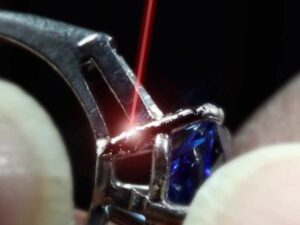
2. Advantages of Laser Welding in Jewelry Making
Laser welding in jewelry making stands as a revolutionary advancement, characterized by precision and efficiency. As a business-to-business enterprise, understanding the numerous benefits of this technology can greatly influence production strategies and final product quality. Here are ten notable advantages:
- Enhanced Precision: Allows for highly detailed and accurate jewelry designs.
- Durability: Creates stronger joints, resulting in jewelry that lasts longer.
- Reduced Waste: Minimizes material wastage compared to traditional methods.
- Time-Efficiency: Shortens the production cycle, facilitating quicker deliveries.
- Cost-Effectiveness: Lower labor costs due to automated processes.
- Safety: Reduces workplace hazards, as it is a non-contact process.
- Versatility: Suitable for a wide range of metals and alloys.
- Minimal Post-Processing: Requires less finishing work, preserving intricate details.
- Environmentally Friendly: Uses less energy and creates less waste, supporting sustainable practices.
- Improved Aesthetics: Results in smoother, cleaner lines and surfaces, enhancing the jewelry’s appeal.
Thus, this proves that laser welding emerges as a robust and forward-thinking choice for modern jewelry production in any business sector.
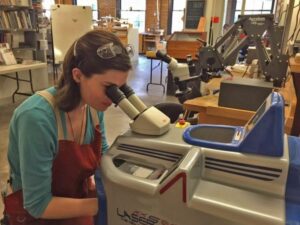
3. Laser Welding Techniques
In a realm where innovation is the cornerstone of success, understanding various laser welding techniques can elevate a business to new heights. As enterprises strive to stay ahead of the curve, acquainting themselves with advanced laser welding techniques is pivotal. Below are four techniques that have been revolutionizing the jewelry manufacturing sector, each providing a distinct approach to crafting exquisite pieces.
Contour Welding
According to ScienceDirect, Fast welding speeds were achievable with contour welding. It is a technique known for its proficiency in creating complex and intricate designs. The laser beams meticulously trace the contours of the jewelry piece, crafting detailed and complex patterns that result in striking finishes.
For example, a renowned jewelry house recently unveiled a collection where each piece prominently showcased the finesse achievable with this technique, meeting the burgeoning demand for one-of-a-kind, sophisticated jewelry items.
Quenching
Quenching emerges as an indispensable tool in the repertoire of laser welding techniques, especially when the focus is on enhancing the durability of the jewelry pieces. This technique specializes in hardening selected areas of a piece, thereby amplifying its resilience and longevity.
I have witnessed at Rexjewel that by rapidly cooling the targeted areas, it accomplishes a desirable level of hardness. This results in creations that not only capture the eye but also promise an enduring lifespan, thus fulfilling the industry’s commitment to quality and durability.
Pulse Shaping
Harnessing the potential of pulse shaping can redefine the quality and aesthetics of the weld. This method allows for the alteration of laser pulses, effectively managing the heat input and consequently, dictating the weld shape.
It ensures meticulous craftsmanship, where the risk of material damage is mitigated substantially. By adopting this approach, businesses can create products that embody quality and elegance, showcasing a harmonious blend of technology and artistry, a facet prominently seen in recent industry exhibitions.
Conduction Welding
In the spectrum of laser welding techniques, conduction welding occupies a significant position, noted for its proficiency in yielding smooth, superior-quality welds with minimal distortion. This method is particularly advantageous when maneuvering delicate materials, offering a safe haven from potential overheating and damage.
It assures the integrity of materials while promising reliability and unmatched quality. From my experience, this establishes itself as a vital asset for businesses keen on presenting products that stand as paragons of excellence and innovation.
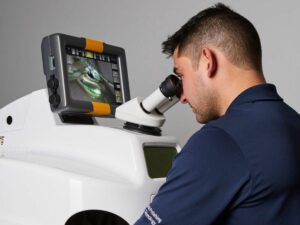
4. Laser Welding Process
The arena of jewelry manufacturing has witnessed a paradigm shift with the advent of laser welding technology. This innovative approach demands a comprehensive understanding of the sequential processes involved. Here, we depict a five-step guide to mastering the laser welding process, providing insights that can equip businesses to forge ahead with confidence and expertise.
Step#1 Material Preparation
Material preparation is the initial and critical step in the laser welding process, where the materials to be welded are cleaned and arranged appropriately. This step ensures that the materials are devoid of contaminants that could potentially hinder the welding process. It promotes adherence. It ensures quality. It lays the foundation for a smooth welding process, promising products that mirror precision and quality.
Step#2 Laser Configuration
Setting up the laser parameters correctly is a crucial step that dictates the success of the welding process. During this phase, the laser’s power, speed, and focus are adjusted according to the material’s characteristics and the desired outcome. It’s a pivotal step. It demands expertise. It sets the stage for a seamless welding process, thereby enabling the creation of products that reflect professionalism and excellence for businesses.
Step#3 Welding Execution
The welding execution step is where the actual welding takes place, following the parameters set in the previous step. It involves directing the laser beam onto the material to create a weld that is both aesthetically pleasing and structurally sound. This step is central to the process. It showcases skill. It embodies the convergence of technology and craftsmanship, marking a significant milestone in the creation of pieces.
Step#4 Cooling
Following the welding execution, the cooling step takes precedence, where the welded materials are allowed to cool down to solidify the weld. This step is essential to prevent any potential distortions and maintain the integrity of the design. It promotes stability. It is indispensable. It serves as a safeguarding phase, ensuring that the final products resonate with quality and durability, essential traits for businesses’ market reputation.
Step#5 Inspection and Finishing
The final step in the laser welding process involves meticulous inspection and finishing to ensure that the weld meets the desired quality standards. At this stage, any necessary adjustments or polishing is carried out to achieve a flawless finish. This step ensures perfection. It embodies quality control. It stands as the final checkpoint, where products are refined to meet the high standards expected in the modern jewelry market.
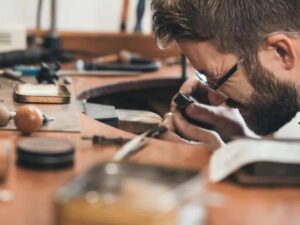
5. Applications of Laser Jewelry Welding
In the ever-evolving landscape of jewelry manufacturing, laser jewelry welding has emerged as a beacon of innovation and precision. It brings a slew of applications that are transformative, catering to various facets of the jewelry industry. Below, we delve into four critical applications of laser jewelry welding that have the potential to redefine craftsmanship and quality in this sector.
Repairing and Restoration
Laser welding has revolutionized the repairing and restoration aspect of jewelry manufacturing, enabling seamless rectifications and improvements without damaging surrounding areas. This application allows for precise adjustments, ensuring that pieces retain their original charm and luster. It is precise. It preserves value.
Creation of Intricate Designs
The application of laser welding in crafting intricate designs is undeniably significant. It permits the creation of complex patterns with an unmatched level of detail, thereby enabling manufacturers to expand their portfolio with high-quality, sophisticated pieces. It stands as a vital tool in the arsenal of manufacturers aiming to carve a niche in the market with unique, artisanal creations that resonate with modern consumers.
Stone Setting
Laser welding facilitates a more secure and precise stone setting, ensuring the stones are firmly anchored without the risk of damage during the setting process. This technique has altered the dynamics of stone setting, fostering a perfect amalgamation of durability and aesthetics. It’s a game-changer. It guarantees stability.
Production of Custom Jewelry
Custom jewelry production has witnessed a significant boost with the advent of laser welding technology. As an example, this application allows for the production of unique, personalized pieces that meet specific customer preferences, fostering a closer connection between the brand and the consumer. It encourages personalization. It fosters brand loyalty.
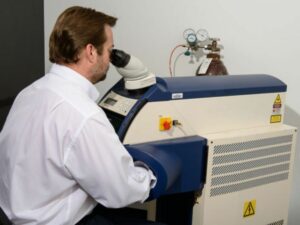
6. Laser Welding vs. Traditional Methods
In the dynamic world of jewelry manufacturing, the choice between laser welding and traditional methods significantly impacts product quality and production efficiency. For B2B entities navigating this industry, it is critical to discern the strengths and challenges of both techniques. Here, we present an in-depth comparison to assist enterprises in making informed decisions:
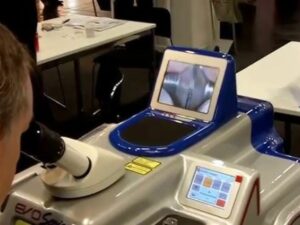
Laser Welding
Highlights:
- Laser welding is synonymous with precision, capable of producing intricate designs with high accuracy, which is a significant benefit for crafting high-end jewelry pieces.
- This method is known for creating stronger and more durable bonds, enhancing the longevity of jewelry items, which is a notable advantage in the B2B sector.
- The non-contact nature of laser welding reduces material wastage significantly, promoting a more sustainable and cost-effective manufacturing process.
- Laser welding supports automation, which can lead to a substantial reduction in labor costs, fostering higher profit margins for businesses.
- The environmental footprint is considerably less with laser welding as it consumes less energy and generates fewer emissions compared to conventional methods.
Challenges:
- The initial setup and equipment costs for laser welding can be quite high, potentially acting as a barrier for small to medium enterprises.
- Specialized training is required to operate laser welding machines proficiently, adding to the operational costs.
- It might not be suitable for welding certain types of metals or alloys, limiting its versatility in jewelry manufacturing.
- The complexity of laser welding machinery means maintenance can be both time-consuming and costly, which might influence the overall production cycle.
- Companies might face challenges in integrating laser welding into existing manufacturing setups, necessitating considerable adjustments and changes.
Traditional Methods
Highlights:
- Traditional methods, being well-established, allow for a more straightforward and less technical setup, which can be a boon for smaller enterprises.
- They offer a broader versatility in terms of the materials that can be worked with, facilitating a more extensive range of jewelry designs and styles.
- The artisanal aspect of traditional methods can bring a unique, hand-crafted quality to jewelry pieces, which can be a distinctive selling point in the B2B market.
- Traditional methods usually involve simpler machinery and tools, which can be less costly to maintain over time.
- Being entrenched in the industry, traditional methods enjoy a wide base of skilled labor, easing the process of finding experienced artisans.
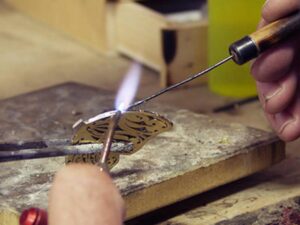
Challenges:
- Traditional methods may entail higher material wastage, which could potentially increase production costs.
- The production cycle can be significantly lengthier compared to laser welding, potentially delaying delivery timelines.
- Achieving a consistent quality can be more challenging, given the manual aspect of these methods.
- Traditional methods generally involve more physical processes, which might increase the risk of workplace accidents and injuries.
- The environmental impact can be more substantial with traditional methods, given higher energy consumption and waste generation.
7. 4 Tips for Successful Laser Jewelry Welding
It is crucial for businesses aiming to carve a niche in this competitive market to hone their skills and adapt to these modern techniques. In this regard, we present a compilation of essential tips that can guide enterprises to achieve successful outcomes in laser jewelry welding. See the following below:
#1 Appropriate Material Selection
Selecting the right materials is foundational to the success of laser jewelry welding projects. By choosing materials with suitable properties, businesses can ensure a smoother welding process and high-quality outcomes. It’s about precision. It’s about quality. It necessitates a thorough understanding of material properties to select those that can withstand the intense heat generated during the laser welding process.
#2 Regular Maintenance
The key to ensuring an uninterrupted and efficient welding process lies in the regular maintenance of welding equipment. This step is vital in preserving the operational efficacy and longevity of these intricate machines. It is crucial. It is foresighted. It embodies a proactive approach to maintaining the machinery in optimal condition, thereby preventing unexpected downtimes and ensuring consistent quality in welding projects.
#3 Adequate Training for Technicians
Investing in the proper training of technicians can be a game-changer for businesses venturing into laser jewelry welding. A well-trained technician can adeptly handle the equipment, ensuring that the welding process is conducted with utmost precision and efficiency. It’s a necessity. It’s a priority. It fosters a team of professionals who can drive the business toward success by leveraging their expertise and skills.
#4 Implementation of Safety Measures
Implementing safety measures is not only a mandatory requirement but also a vital aspect of ensuring the well-being of the workforce. This focus on safety promotes a harmonious work environment where technicians can perform their tasks without any undue risks. It is prudent. It is responsible. It aligns with the business ethics of prioritizing employee safety.
| Phase/Aspect |
Safety Measures |
Why It Matters |
| Workspace Setup |
Designate a specific area for laser operations, free from unnecessary clutter. Ensure proper ventilation to dissipate heat and remove fumes. |
Prevents fire hazards, ensures clean air, and delineates a clear workspace. |
| Personal Protective Equipment (PPE) |
Wear laser safety goggles appropriate for the laser’s wavelength. Use heat-resistant gloves and wear a lab coat or apron. |
Protects eyes from harmful laser radiation and body from accidental burns or laser exposure. |
| Equipment Handling |
Always check laser alignment before operation. Ensure the laser is regularly maintained and cleaned. |
Prevents equipment malfunctions and ensures the laser works efficiently and safely. |
| Laser Operation |
Never bypass safety interlocks. Always operate lasers with the minimum power necessary for the task. |
Reduces the risk of unintended laser exposure or accidents. |
| Material Handling |
Understand the material’s reaction to laser exposure (some materials might release toxic fumes). Secure materials properly to prevent movement during processing. |
Prevents exposure to harmful substances and ensures accurate and safe laser processing. |
| Training |
Ensure all operators are trained in laser safety protocols. Regularly update training with new safety information or techniques. |
Equips operators with the knowledge to work safely and handle emergencies. |
| Emergency Protocols |
Have a first-aid kit accessible in the workspace. Install a fire extinguisher suitable for electrical fires nearby. |
Prepares the workspace for immediate response in case of accidents or fires. |
| Signage |
Clearly mark the laser operation area with warning signs. Indicate potential hazards and required PPE at entrances. |
Informs others in the area about potential hazards and necessary precautions. |
| Fume Extraction |
Use appropriate fume extractors or ventilation systems. Regularly inspect and clean extraction systems. |
Protects operators from inhaling potentially harmful fumes and maintains a safe air quality in the workspace. |
| Electrical Safety |
Ensure the laser system is properly grounded. Regularly inspect cords, plugs, and connections for damage. |
Prevents electrical hazards, shocks, and potential equipment malfunctions. |
Dive Deeper Into Our Resources
For some insightful reads, we’ve curated a list of recommended articles just for you:
Still haven’t found what you’re looking for? Don’t hesitate to contact us. We’re available around the clock to assist you.
Conclusion
In this guide, we navigated the sophisticated realm of laser jewelry welding, illuminating its vital aspects and sharing essential tips for business success in this sector.
As entrepreneurs seek to forge ahead in the jewelry industry, we encourage businesses to consider collaboration opportunities with Rexjewel, a reliable name in jewelry manufacturing. We stand ready to assist with detailed insights and answers to any queries. Contact us today and let’s start fruitful alliances.







